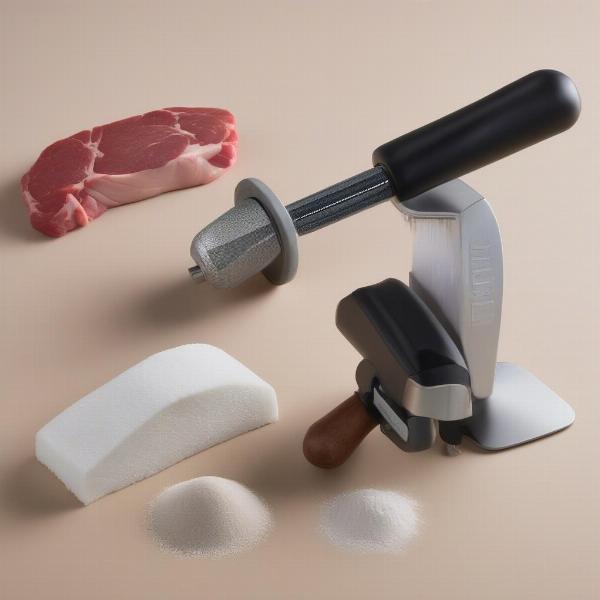Meat tenderizer is a common kitchen staple, used to break down tough muscle fibers and make meat more palatable. But what about using it for your furry friend? The question of whether meat tenderizer is safe for dogs is a complex one, and the answer, unfortunately, isn’t a simple yes or no. While the idea of tenderizing meat for your dog might seem like a way to make their meals more enjoyable, it’s crucial to understand the potential risks involved.
Understanding Meat Tenderizers and Their Effects on Dogs
Meat tenderizers typically work in one of two ways: mechanically or chemically. Mechanical tenderizers, like mallet pounders or jaccard blades, physically break down muscle fibers. Chemical tenderizers, on the other hand, use enzymes like papain (from papaya) or bromelain (from pineapple) to achieve a similar effect. While some natural enzymes in small amounts might not be harmful, the concentrated forms found in commercial meat tenderizers can pose problems for dogs.
One of the main concerns is the potential for digestive upset. Dogs’ digestive systems are different from ours, and the enzymes in meat tenderizer can disrupt their natural gut flora, leading to vomiting, diarrhea, and other gastrointestinal issues. Additionally, some meat tenderizers contain added salt and other seasonings, which can be toxic to dogs in large quantities.
 Types of Meat Tenderizers
Types of Meat Tenderizers
Another potential issue is the risk of allergic reactions. Some dogs may be sensitive to the enzymes or other ingredients in meat tenderizer, leading to skin rashes, itching, or even more severe allergic reactions. If you notice any of these symptoms after your dog has consumed meat tenderized with a commercial product, contact your veterinarian immediately.
Safe Alternatives to Meat Tenderizing for Dogs
If you’re looking to make your dog’s meat easier to chew, there are safer alternatives to using meat tenderizer. One option is to simply choose cuts of meat that are naturally more tender, such as chicken breast or ground beef. You can also slow cook meat to break down the tough fibers, making it easier for your dog to digest.
Another approach is to puree or finely chop the meat before feeding it to your dog. This is particularly helpful for senior dogs or those with dental issues. Adding a little bit of warm water or low-sodium broth can also help soften the meat and make it more appealing.
When to Consult a Vet
If you suspect your dog has ingested meat tenderizer and is showing signs of distress, contact your veterinarian immediately. Symptoms such as vomiting, diarrhea, excessive drooling, or difficulty breathing require prompt medical attention.
Conclusion
While the idea of tenderizing meat for your dog might seem well-intentioned, the potential risks associated with commercial meat tenderizers outweigh the benefits. Opt for safer alternatives like slow cooking, pureeing, or choosing naturally tender cuts of meat to ensure your furry friend enjoys a healthy and delicious meal. Always consult your veterinarian if you have any concerns about your dog’s diet.
FAQ
- Is it ever safe to give my dog meat tenderized with commercial products? Generally, it’s best to avoid using commercial meat tenderizers for dogs due to the potential for digestive upset and allergic reactions.
- What should I do if my dog accidentally eats meat tenderizer? Monitor your dog for any signs of distress, such as vomiting or diarrhea. If you notice any unusual symptoms, contact your veterinarian immediately.
- Are there any natural ways to tenderize meat for my dog? Slow cooking or pureeing are safe and effective ways to make meat more tender and easier for your dog to digest.
- What are some good cuts of meat for dogs that are naturally tender? Chicken breast, ground beef, and fish are generally good options.
- Can I use pineapple or papaya to tenderize meat for my dog? While these fruits contain natural enzymes that can tenderize meat, it’s best to avoid giving them to your dog in large quantities as they can cause digestive upset. Consult with your veterinarian for appropriate portion sizes.
- What are the signs of an allergic reaction in dogs? Signs of an allergic reaction can include skin rashes, itching, swelling, vomiting, and difficulty breathing.
- What are some other ways to make my dog’s food more appealing? Adding a small amount of warm water or low-sodium broth to your dog’s food can make it more palatable.
ILM Dog is a leading online resource for dog owners worldwide, offering expert advice on all aspects of dog care, from breed selection to health, training, nutrition, and more. We are committed to providing practical, reliable information to help you provide the best possible care for your furry companion. For more helpful tips and guidance, visit us at ILM Dog. Contact us at [email protected] or +44 20-3965-8624 for personalized advice and assistance.